What is traditional bread anyway? The more I read, the murkier this question becomes. Steamed golden crusts, curling gringe, high protein flours mixed into sloppy doughs and possibly even salt are a pretty new phenomena in the history of bread – yet they are marketed as ‘traditional’. Don’t get me wrong, I don’t want to create ‘traditional bread’ but I do like to understand where we came from to get were we are going. I guess I don’t want to get caught up in trends. Saying this however, I do have a particular bent towards French bread. And although I have a fairly limited understanding of bread history I know how much I love the aromas and flavours of my levain─and the French placed a massive importance on baking with a perfectly ripe levain. This resonates with me.
My recent baking with French flours brought home a desire to try and produce flavourful high extraction flour using Australian wheat grains. Again I am using my favourite Australian biodynamic wheat grains courtesy of ‘Four Leaf Milling’. It is a white winter wheat from South Australia with a protein level of 10.9%─full of colour and flavour with just enough strength.
[url=http://www.flickr.com/photos/67856223@N06/7282841268/] [/url]
[/url]
[url=http://www.flickr.com/photos/67856223@N06/7282840600/]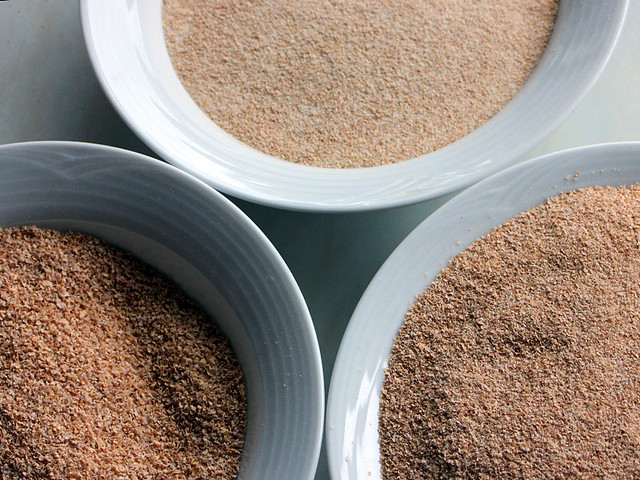 [/url]
[/url]
In the past my method for producing high extraction flour was a single pass through my Komo mill on its finest setting then sift through a 20 mesh sieve (I think) and remill the caught material. This was sifted again with the caught material set aside. This would usually only remove 10% of the total weight of flour i.e. 90% extraction. And while this was delicious flour it wasn’t producing the crumb colour that I had in mind. I needed to purchase a finer sieve and I settled upon a 50 mesh Keene classifier and changed my method to a more labour intensive multiple pass milling method.
Method is a loose term though─I started by cracking the grains and sifting the coarsest pieces. This was continued with gradually finer settings on the mill and sifting through finer sieves. Any flour that passed through the 50 mesh was set aside until the end when it was combined with a small amount of the finest milled middlings to build the quantity to the correct weight for an 80% extraction flour.
[url=http://www.flickr.com/photos/67856223@N06/7282839794/]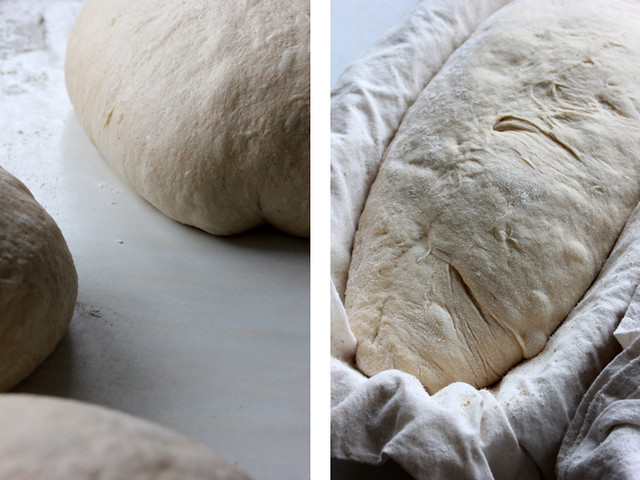 [/url]
[/url]
I was excited even before I used the flour. It was softest, silkiest and most beautifully coloured flour I had ever produced through the mill. Plus it had all the wonderful fragrance of freshly milled flour.
Continuing with my French themed baking of late I decided to bake a miche, fendu (French for split) and batard using the freshly milled high extraction flour. My baking of late has shifted from long bulk ferments to concentrating on short controlled levain builds and mixing dough with larger amounts of pre-fermented flour. The short bulk ferment makes it easier to control temperatures in winter and assists with my goal of sweet tasting bread. At the end of bulk fermenting I was surprised by the balance of extensibility and strength─especially considering it was mixed with freshly milled flour. I named the miche in honour of the town of Tarlee where Four Leaf Milling is based.
[url=http://www.flickr.com/photos/67856223@N06/7282839088/]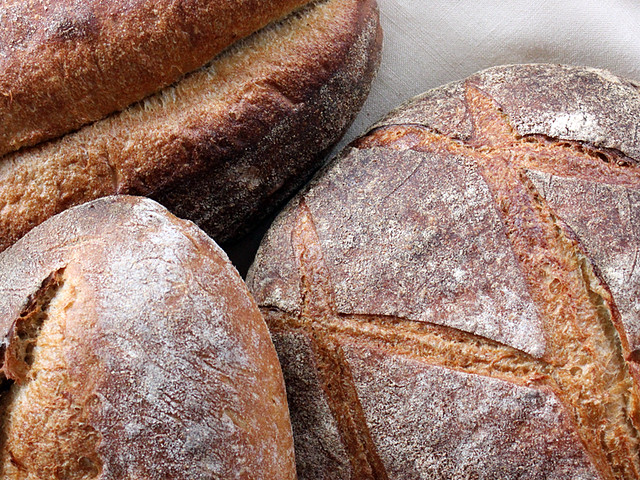 [/url]
[/url]
Tarlee Miche and French breads (1 x 2kg Miche, 1 x 1kg Fendu, 1 x 1kg Batard)
Formula
Overview | Weight | % |
Total dough weight | 4000g |
|
Total flour | 2260g | 100% |
Total water | 1740g | 77% |
Total salt | 40g | 1.8% |
Pre-fermented flour | 565g | 25% |
|
|
|
Levain – 6hrs 25-26°C |
|
|
Previous levain build | 215g | 50% |
Flour (I use a flour mix of 70% Organic plain flour, 18% fresh milled sifted wheat, 9% fresh milled sifted spelt and 3% fresh milled sifted rye) | 430g | 100% |
Water | 258g | 60% |
Salt | 4g | 1% |
|
|
|
Final dough. DDT=25-26°C |
|
|
Levain | 907g | 53% |
Freshly milled flour sifted to 80% extraction | 1695g | 100% |
Water | 1401g | 82% |
Salt | 36g | 2% |
Method
- Mix levain and leave to ferment for 6 hours at 25-26°C
- Mill and sift flour and allow to cool to room temperature before mixing with water (hold back 50 grams of water) and autolyse for a minimum of one hour.
- Add levain to autolyse then knead (French fold) 5 mins. Return the dough to a bowl and add salt and remaining 50 grams of water and squeeze through bread to incorporate (dough will separate then come back together smoothly) then knead a further 10 mins.
- Bulk ferment two hours with a stretch-and-fold after one hour.
- Divide. Preshape. Bench rest 30 mins. Shape into desired shapes.
- Final proof was for 2.5 hours at 21°C (this was quite variable – watch the dough)
- Bake in a preheated oven at 250°C for 10 mins with steam then reduce temperature to 200°C. Miche was baked for a total of 50 min. The batard and fendu were baked for a total of 40 min.
Cutting the Tarlee Miche in half was an exciting moment for me. It had to be straight down the middle. It couldn’t be cut in from the edge. The edge may give you more open crumb but it’s the centre that tells the whole story of the fermentation and oven-spring. From there it was quartered with half of it staying on the bench and the remainder sliced and frozen for the remaining week. All the loaves had thin dark crusts but this was most noticeable on the Tarlee Miche─possibly the perfect kind of crust to crumb ratio. Inside was slightly golden and sweet and more open than I imagined it would be. There is another photo of me with a huge grin after I had cut the miche ... it said it all.
[url=http://www.flickr.com/photos/67856223@N06/7282838108/] [/url]
[/url]
[url=http://www.flickr.com/photos/67856223@N06/7282837260/] [/url]
[/url]
[url=http://www.flickr.com/photos/67856223@N06/7282836308/] [/url]
[/url]
[url=http://www.flickr.com/photos/67856223@N06/7282835532/]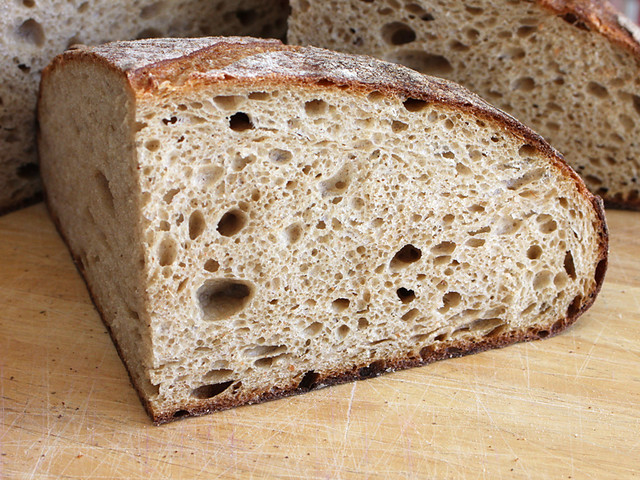 [/url]
[/url]
[url=http://www.flickr.com/photos/67856223@N06/7282834802/] [/url]
[/url]
[url=http://www.flickr.com/photos/67856223@N06/7282834064/]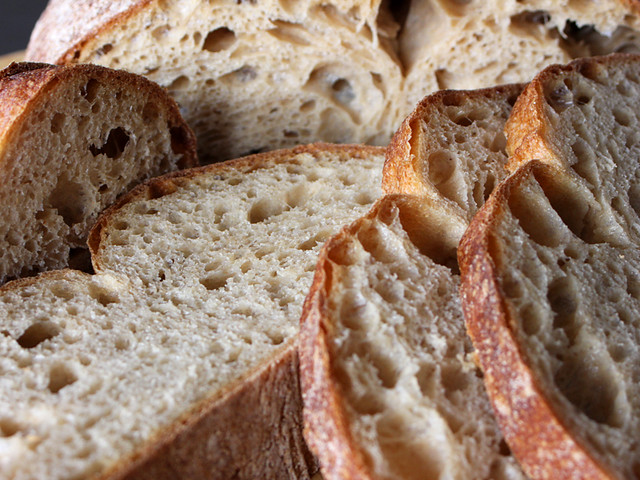 [/url]
[/url]
[url=http://www.flickr.com/photos/67856223@N06/7282833338/]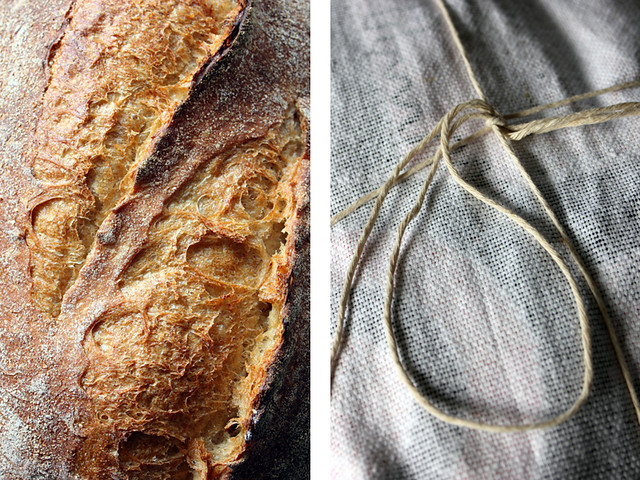 [/url]
[/url]
Biscuits
Kids were kept busy in the kitchen as well. Nat had some very enthusiastic help making and decorating biscuits with lots of finger licking followed by lots of hand washing─this seemed to happen often. After the biscuits were rolled, cut and baked the excitement was taken up a notch as it was decorating time. I can vouch that they tasted even ‘sweeter’ than they look. Needless to say we were hounded for biscuits at breakfast, lunch and dinner. Oh the disappointment when they were declined.
[url=http://www.flickr.com/photos/67856223@N06/7282832210/]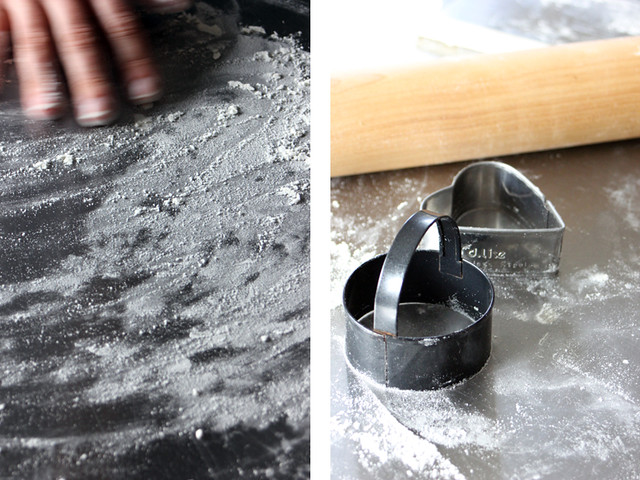 [/url]
[/url]
[url=http://www.flickr.com/photos/67856223@N06/7282831576/]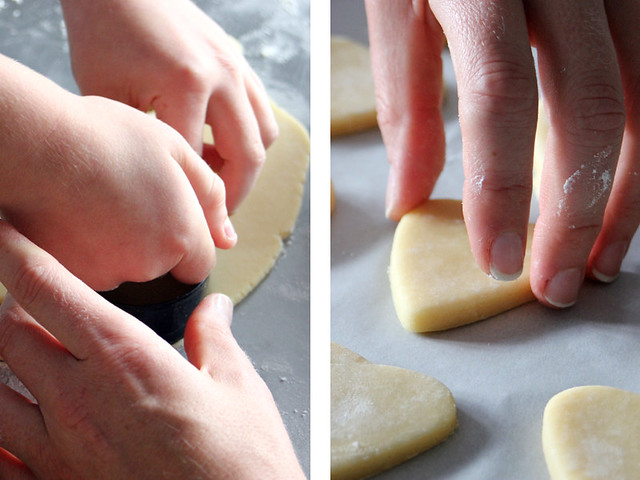 [/url]
[/url]
[url=http://www.flickr.com/photos/67856223@N06/7282830896/] [/url]
[/url]
Rosella Jam
A week ago I was baking with Laurie again, this time for the Hampton Food and Arts Festival held outside of Toowoomba. It was a beautiful day and we again sold out of bread by lunch-time much to the regret of late shoppers. While wandering the stalls Nat purchased a small bag of rosella fruit. Rosella shrubs are sometimes called the Queensland jam plant and it is a native of coastal New South Wales and Queensland. It is a versatile plant with both edible fruit and foliage. The fruit is most often made into very popular jams but can also be dried and used in tea making.
We spent a lazy afternoon peeling fruit and simmering jam for bottling. And the result is a richly coloured jam that could be best described as being similar to plum jam but tarter. Delicious.
[url=http://www.flickr.com/photos/67856223@N06/7282830282/]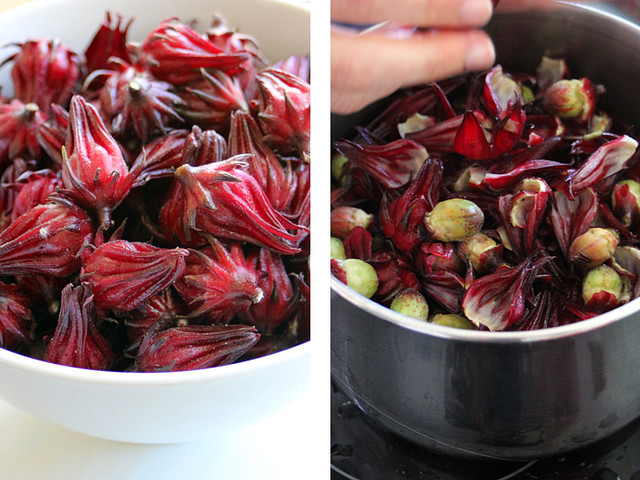 [/url]
[/url]
[url=http://www.flickr.com/photos/67856223@N06/7282829702/] [/url]
[/url]
[url=http://www.flickr.com/photos/67856223@N06/7282829122/]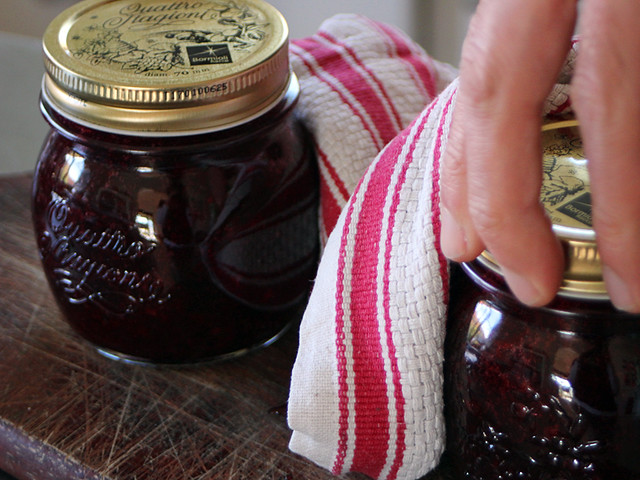 [/url]
[/url]
[url=http://www.flickr.com/photos/67856223@N06/7282828490/]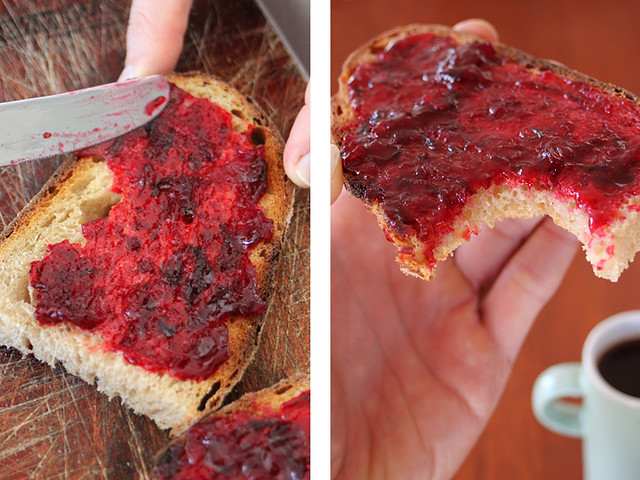 [/url]
[/url]
I am now laying low with a nasty head cold … no more jam for me until I can taste again─it’s too good to waste!
Cheers,
Phil ** sniffle, sniffle
- PiPs's Blog
- Log in or register to post comments
Hello Hans,
Thank you so much for your generous words.
I think there is a history of larger pre-ferment amounts in pain au levain. The bakers would be building up the levain through the three traditional refreshments. From the 'levain de chef' to the 'levain de premiere' (1st refreshment) to the 'levain de seconde' (2nd refreshment) and finally the 'levain de toute pointe' (final refreshment) ... The final being the most important the to judge the readiness of ... this would be used quite early so as not to spoil. The young levain would then be mixed to a final dough. All the earlier mixing of levain refreshments would lessen the amount of final kneading required by the bakers since a large proportion of young levain could be used in the final dough without bringing too much acidity.
Now I believe they did know that a single refreshment over 8-12hrs would work just as well but it was just too hard to control the fermentation over this period of time in the bakery environment ... so the two and three builds prevailed until bakers yeast became more common place and other social changes allowed bakers time away from their bakeries.
As Gerard Rubaud has said they were slaves to the levain.
Sorry if I am blabbing on about stuff you probably already know ...
Cheers,
Phil
Hello Phil,
The folks at Four Leaf Milling must be overjoyed and what you’ve created using their wheat!
The flours in the levain, and your freshly-milled flour, must have combined to make incredible-tasting bread.
I love the photo sequence, slicing into that miche – the crumb is absolutely amazing - the photo of that perfect ‘wedge’
is really something! (Having a hard time finding an adequate adjective :^) ).
I’m bookmarking this post, not only for the incredible beauty of the breads, but also for a ‘how-to’ on milling and sifting high-extraction flour at home (also noting how you are adjusting preferment quantity and bulk ferment timing , having the same challenge maintaining temperatures in the cooler months).
Thanks for writing about your rosella fruit – it does make a beautifully-colored jam! – lovely to have Australian jam with your Australian wheat bread :^)
Thanks for the post and hope you are feeling better soon, Phil!
:^) breadsong
Hi Breadsong,
On doctors orders I am at home resting and fighting a sinus infection ... yuck :(
I hadn't thought about the Australian jam with Australian wheat bread ... it is a lovely thought.
The miche has been the most enjoyed and exciting breads to come out of the kitchen in a while. It tastes amazing ... I am quite disappointed I can't taste or smell anything at the moment. As a 'raggedy homebaker' I sometimes take for granted how important my senses are in the process. It is really hard at the moment not being able to smell the levain to judge its readiness. Anyway ... enough of me whinging :)
Are you any closer to finding a mill in your kitchen?
Cheers,
Phil
Hi Phil,
I hope you are all better now and thanks for inquiring re: the mill.
Sorry to report there has been no progress on the home-milling front but I think about it every time I see the superb bread you create using your home-milled-and sifted flour!
:^) breadsong
hi Phil,
I enjoyed your post but especially because I grew up eating Rosella Jam. I haven't had it in forever.
Joanne
Hi Joanne,
Hope I haven't made you too homesick :)
This was the first time I have made it ... gee it's good stuff isn't it.
Cheers,
Phil
Hi Phil,
Love hearing about your latest experiments and really love the photos - especially the little hands helping out in the kitchen :-)
Interesting that you are toying around with higher amts. of prefermented flour to get a sweeter taste. I remember reading about that when I first started out on Mike Avery's web site and it didn't make any sense to me. How could more mean less...... Now it does especially since I am toying around with my leaven builds. Easy to see what time does aroma wise as a leaven/bread sits. Lots to learn about the yeasties and beasties that I am tending and how a few degrees change in their environment makes a world of difference.
I will have to give your Tarlee Miche formula a go and see what my daughter says about the flavor since she is my #1 sour 'rater'. I do have lots of extra leaven now due to my experiments and I still hate tossing any :-) Yours looks wonderful. My flours with have to forgo the sifting though. I tried that once and it drove me nuts....just one too many steps for me.
Hope you are feeling better soon.
Take Care,
Janet
Hi Janet,
The kids had a great time in the kitchen ... the trick is how to curb the enthusiasm a little :)
When using the larger amount of levain temperature and time become even more critical if you're trying to keep the flavours balanced. I have made some very sour bread (it was delicious though) in the past after using a single built levain that was well past it's prime ... summer can be a shocker for this :)
The sifting is certainly another process ... and it does take time, and with this method even more so. But I am hooked now :)
Cheers,
Phil
- ay, that's the ticket, laddie...
Although the millers at Heartland Mills tell me only one milling pass for high extraction flour - I believe that they can stand a much higher sifting loss.(And they sift through multiple screens with an eccentric sifter)
They also do not temper the wheat, but I find tempering to be useful.
Lovely bread and pics as always...
Pat
Thenk ye Pat,
I have to say that your blog posts and your to-and-fro's with Bill Wraith are a great source of information and inspiration ... I have learnt a great deal.
I haven't tempered the wheat ... yet. (did see some grain moisture meters on ebay the other day too ... mmm)
I milled these grains at room temperature and found that the multiple pass didn't generate much warmth in the flour. For a single fine pass I have to cool the grains in the fridge first to keep the temperature under control and this seems to lead to the bran shattering.
I collected much larger pieces of bran with the multiple pass method ... I love my komo (maybe not as much as you love your diamant) but I wish I could slow the stones down just a wee bit sometimes ... one of the benefits of hand powered milling I guess.
Thanks again for your kind words, wisdom and inspiration Pat
Cheers,
Phil
I find I get a nicer separation on the bran with tempering. The aim is to bring the grain to 13-14% moisture (or some say more) by increments of about 1% per 24 hours. This goal comes from discussions with the Heartland Mills millers. I have vague memories of reading or hearing about slow tempering producing "better" flour. Most industrial millers temper quickly with steam. I think of this from time to time.
The moisture meter is a big investment. I feel like I don't use mine often, but when I use it, it is very valuable. If I gum up my mill, I can pull it apart and clean it - a mistake on stones is probably pretty serious.
The multiple pass method will not only result in a lower temperature, but may make a difference in starch damage, which will influence the baking quality of the flour.
Milling is a whole diverting subject in itself...
I look at the Komo from time to time. Sometimes I consider how nice it would be to flip a switch and get flour. But the Diamnt does allow me absolute control - of course, I crank it as fast as I can - which will never get to the speed of a motorized mill, but is pretty fast.
Take care of yourself...
Pat
Hi Phil,
Awesome, awesome post. Would you mind if I featured it on the home page for a bit?
-Floyd
Thanks so much Floyd,
That would be wonderful ... cheer me up from my misery guts sick bed :)
Cheers,
Phil
Super bread, little fingers, milling and sifting, beautiful jam I've never heard of and decorated cookies. The crust. color inside and out, and crumb are just delightful. Very nice baking all around.
Hey dabrownman,
I have no idea if rosella jam is ever exported overseas, but it is very popular though reasonably uncommon jam here .... it's found a lot at school fetes, markets and the like.
Thanks for the welcome and kind comments on the post.
Cheers,
Phil
"Perfect" indeed Phil,
wonderful bread!
All good wishes
Andy
Thanks Andy,
... and simple bread too. It made itself ... really :)
Cheers,
Phil
...photos, narrative, process, as always. Every post a work of art. No exception here. Lovely, all.
Fresh milling and 70:18:9:3 levain flour -- Vermont and Queensland aren't as far apart as it may seem.
Thanks for the inspiration!
Tom
Thanks Tom,
Ah ... Gerard Rubaud continues to be a beacon for me ...
The internet certainly has made the world an smaller place ... I often sit and imagine what all fine bakers around the world are doing 'right now'
cheers,
Phil
A sweet revelation to find a crumb like that after all the effort you put into the sifting, and well deserved. I keep coming back to the quarter round shot and thinking what a truly great example of hand crafted bread it is that I'm considering using the photo as a new background for my desktop. Thanks for another very inspiring post Phil, and congratulations on the front page feature!
All the best,
Franko
Thanks so much Franko,
Through the milling process a doubting thought did pop into my head - "what if, after all this time spent on milling and sifting the bread is a complete dud" - well I pushed on anyway.
... and I really did have a stupid big grin on my face after I had cut the miche. And I think it was all the bigger from the amount of time I spent on making these breads.
Cheers,
Phil
As I know the fruit served up as a drink loaded with vit. C. (Can you tell I haven't been to your continent yet?) Makes a great "sturm" in a pinch! Maybe worth making some tea to help your cold :). Hey! We got Tasmanian blue gum trees growing all over the place here in Cantabria, Spain. (brought in some 150 yrs ago) I picked up some gum nuts and have a small tree in a pot.
Incredible write up, photos, and loves loaves! That wedge photo (among others) is so impressive, I understand the need for words! It looks just too perfect! Too perfect! Congratulations on making the face page! Yes!
Now for the killer Q for stuffy nose... Have you tried a 4 kg loaf yet? ...or thought about it?
Mini
Oh Rosella tea would be perfect for me right now ... I am a big drinker of rooibos tea .... been drinking a bucket load of it the past few days. Thanks for the link, I had no idea the roselle was so prolific ... I really am a sheltered aussie boy :)
Love gum trees ... spent many holidays collecting gum nuts with my mum ... again I am showing my ignorance and had no idea they were planted in Spain ... how wonderful ... you just need some koalas snoozing in them now :)
I'm sure Nat has pictured whomping me over the head with a miche to quiet the coughing :(
Great to hear from you Mini, and thanks again for your gracious words.
Cheers,
Phil
and for me a brand new fruit - wish I could taste the jam. Cool. -Varda
Thanks Varda,
...and the other nice thing is that it is a really easy jam to make. There is a little time spent on separating the pod from the flesh surrounding it. Then both a put in a pot with some water and boiled until the flesh softens and the pods turn clear. The pods are the source of pectin so no lemon juice is required to help with the setting. Just the fruit, water and sugar. The pods are then removed from pot ... this is also tedious (next time I will keep them separate in a muslin cloth perhaps) and the sugar is added ... boil until it passes the set test. Bottle. Water Bath. Done.
Cheers,
Phil
I am sure this story has been told many times and in many different ways but below is my version: A hungry man comes into a town trying to find a place to eat. The first eatery he comes across has a sign that says The Best Hamburger in Town. As he walks near it, there is another eatery that has a bigger signage out front that says The Best Hamburger in This Country and yet another next to it that has an even bigger sign board that says The Best Hamburger in This World! He is baffled, not knowing which one to choose; he continues to walk, until he finds himself standing in front of a small eatery with a small sign board that says, The Best Hamburger on This Street!
I am finding this is what has happened to me: I am standing, well, figuratively speaking, in front of your blog, admiring your Miche ENORMOUSLY.
Thank you very much for posting your Miche. What a great read! And what lovely and refreshing photos, every single one of them, and lovely children!
Your formula of multiple levain builds is most interesting.
I have a few small questions. (1) How did your bottom crust get so brown, nearly charcoaled? The last time I managed to get a bottom crust so brown was using a cast iron pot. It’s uncomfortable for me to try to heat up my baking stone too much in order to get a brown bottom crust. (2) When you kneaded a further 10 minutes, was this French fold again or just normal hand kneading? That was a lot of dough to handle by hand. (3) Do you use fan-forced heat or conventional (top and bottom heat)?
Thank you again.
Shiao-Ping
Hi Shiao-Ping,
How wonderful to hear from you!
I am so glad you enjoyed the miche posting and thanks for you thoughtful words ... it was a good loaf ... but there is not that much left of it now ... bread is such a transient thing :)
The multiple levains works well if I am around the house ... but I am flexible and I still use a single builds. For instance the other day I did a single build that rose slowly in cool temperatures all day. I mixed the dough and when shaped I placed it outside on the porch about 9pm at night and let rise at 12-13C until 6am the next morning when it was baked. It was made with the french T65 flour and was SO delicious. I love this time of the year for baking. I feel like I have so many options.
I bake on a thick piece of granite and have another baking stone at the top of the oven above the bread. I really crank up the heat, and I wanted a lot of heat for the miche to punch it up. The reason I use so much heat is that I am unable to turn off the fan in our convection oven so I have to switch the whole oven off for the first 10mins of baking when adding steam. I have an oven thermometer, and when the temperature drops to 200C I switch the oven back on and bake normally with convection. I turn the loaves half way through the bake also. This has led to a pretty dark crust on the base but still lighter than when I use a cast iron pot ... this tends to scorch the bottom of loaves if I am not careful.
Yes, I french fold (slap-and-fold) most doughs I make unless they are a lower hydration. I have kneaded up to 6kgs of dough this way without too much trouble. I am over 6ft so I can throw it around pretty easily :)
cheers,
Phil
Thank you for your reply. I too love this time of the year for making sourdough. My country sourdough with roasted caraway seeds was also left out on the kitchen bench overnight and baked the next morning. So easy to manage the fermentation at this time of the year.
Do you pre heat your oven for an hour and a half or more, so both of your baking stones can retain a lot of heat?
I sometimes also turn my loaf upside down half way through the baking to let the bottom browned a bit. That's what you meant when you said you turn the loaves half way through the bake, right? I don't do it very often because a few times the loaves got scrushed like having a nose dive even though I made sure it was two-thirds into the baking time. How do you keep your loaves shapes so well?
I often think that home bakers make better breads than even the most professional bakeries out there, because of the care we give to each and every bread we make. I have sampled many geeat Miches around the world.Without actually tasting it, I think yours would be the best in the world!
Thank you again.
You are much too kind Shiao-Ping,
'best' is such a subjective thing ... and bread can only be so good. :) However it is the best 'miche' I have ever made and probably the nicest bread I have tasted in a long time ... I am a pretty harsh critic, especially of my own bread ... but this had the right texture, right flavour and the crumb had that nice balance that could hold a topping but felt airy when you took a bite.
I like the simplicity and quality of the ingrediants in it ... the flavour of the wheat was the real hero ... I guess this 'raggedy homebaker' just took a step back and let the bread just express itself.
I like to give the stones a really solid pre-heat but I try to do it without wasting the heat ... If I am doing a big bake I will try and use the oven for moderate baking at 160-200C for muffins or biscuits first. This gives the oven an hour of baking time to soak up some moderate heat before I turn it up. It means I can get to a high solid temperature in around an hour. This doesn't always happen and will depend on what I am baking ... for a simple bake of two batards side-by-side I find one hour is enough.
Sorry, what I meant is that I turn the loaves around so the front then faces the back ... I tend to get scorch marks from the fan if I don't.
Cheers,
Phil
Great pictures Phil. The wedge on the front page is beautiful. Excellent crumb. Everything else looks good, too.
Best,
Syd
Hi Syd,
Thanks so much...
Cheers,
Phil
Thanks, I am on the mend now ... antibiotics the size of horse-pills :)
It is beautiful flour and I am looking forward to baking with more of it in the future. Will be interesting to see if I can get a consistent quality with the milling. Thanks again for the postive comments :)
Cheers,
Phil
It's all been said, so no point in my adding anything more...the pic is more eloquent than any words. Superb bake, Phil. As close to the quintessential hand-made sourdough loaf crumb as I've seen.
Cheers
Ross
Hi Ross,
Thanks mate ...
Cheers,
Phil
Great post Phil as usual.
Your bread looks amazing and your photography is spot on as always.
What type of camera are you using and are you using a strobe or natural light?
I never have enough light in my kitchen or house when I usually finish baking so I end up using my built in flash which is not ideal. Now that the weather is nice I will try and take some shots outside on my deck once I get my screenhouse up.
You are starting to convince me I may have to try milling my own flour soon....I just don't know if I have any place to store another piece of kitchen equipment or the flour for that matter! I may need a bigger house....
Cheers.
Ian
Hi Ian,
I am using a Canon 550D ... no lights. Just whatever comes through the windows. This is great on sunny Australian days but a lot trickier on rainy, gloomy days. I don't think I have ever even opened the flash on my camera :)
I am lucky that the Komo is so beautifully crafted ... was easy to convince Nat to allow it some room on the bench. I don't have a mixer or a lot of other clutter so that helps also. Milling adds another step and process that needs time ... but well worth it though.
Cheers,
Phil
What a gorgeous perfect miche along with photos. I would love to taste your jam. The Rosella sounds wonderful and the color is so beautiful. Nothing beats homemade preserves. It's time for jam making at my house.
Sylvia
Thanks Sylvia
I am a jam-maker ... something very enjoyable in the process. I even find preparing the fruit which can be quite time consuming a relaxing endeavour. I also like the challenge of catching the jam at the right setting point. Enjoy your preserving!
Cheers,
Phil
Wonderful post, Phil.
I love the photos, the writeup. Rosella looks most intriguing.
Something in me asks, when will Phil's book appear?
I hope you get better soon,
Juergen
Hi Juergen,
I am so glad Nat picked up the rosellas ... I was flat out at the market and didn't have much of a chance to wander the stalls. It was a lovely surprise.
Ha, no book ... just enjoying the process is enough for me at the moment :)
Cheers,
Phil
Hi Phil,
What was the basis of your autolyse prior to levain incorporation? Perhaps this is a common path but unfamiliar to me from limited experience. Autolyse before salt - yes. But before levain? Specific to freshly milled flour? Something gleaned from Clavel? btw, am I correct in assuming the elegant French levain build figure came from his book?
Sorry - but when one posts a triumph like that Cover Girl miche, readers are destined to parse your formula and process to death. Mea culpa.
Thanks!
Tom
Hi Tom,
I tend to think of an autolyse as including flour and water and nothing else. This is the traditional view of it. This works if you are using a firm levain/starter. If however you are using a liquid starter which contains a larger proportion of the dough liquid then the starter may need to be incorporated into the autolyse. (otherwise the autolyse is too dry) Just be be aware that as soon as the starter is incorporated fermentation begins ... the clock starts ticking :)
I use a long autolyse for a variety of reasons .... and none of them are for the main reason that Professor Calvel championed it's use. He was concerned about the widespread use of highspeed mixing to develop dough maturity. This had a bleaching effect on the dough and contributed to flavour loss as well. As I am hand mixing this is never going to happen .... but the autolyse helps me in other ways by decreasing the mixing time needed and with water absorption when using freshly milled wholegrain flours.
Are you talking about the image in my reply to Hans? No I found that on a boulangerie website - it was included in a lecture on levains. I think it is beautiful. There were even more complicated ones that included a constrantly refreshed levain that used old dough ... made my head hurt looking at them :)
Cheers,
Phil
Hi Phil,
Did you find it here? Looks great!
http://translate.google.co.uk/translate?hl=en&sl=fr&u=http://www.boulangerie.net/loi/DossierLecturelevain/acc.html&ei=pP3GT7fIDYrS8gPx94mdDg&sa…
Best wishes
Andy
Yep, thats the one.
It's a really interesting read ...
Cheers,
Phil
You did it again! :)
Studying for my magazine, I have been reading and searching for information on flour -- it's a vast fiel and I feel I have just scratched the surface. One of the questions that I have been thinking about is how you can get finer flour from a home mill (or any stone mill for that matter) -- this post made the answer again clearer.
Thanks for sharing your experiments!
Glad I could help Jarkko :)
Also have a look at proth5's blog for an extensive amount of information on home milling and sifting.
Hope your magazine is coming along nicely.
Cheers,
Phil
Thanks for the tip, Phil!
Also, maybe you could help me with one more question...? :) In The Bread Builders, Dan Wing talks about how wholegrain flour goes rancid quickly, stating that as a reason why you should grind your own. On the other hand, I haven't noticed this in the store-bought flour I'm using.
So, I was wondering... do you think this only applies to stone ground flour? Or have I just been lucky to buy small enough packages of flour and use them quickly enough?
Cheers!
Hi Jarkko,
There is a lot of conflicting anecdotal advice out there. Some say that the oil in the germ will turn rancid, but I think you have quite a few months of good use if stored correctly. Then there is the talk of aging the flour ... some say use immediately or with within 12 hrs for wholegrain flours. I have seen no difference and it is easier for me to store grain and mill what I need just before use.
Store bought wholemeal/wholegrain flour can be a bit tricky. Unless it it stone-ground it probably has had the germ removed during milling so it will store well. I have heard even it is labelled 'stone-ground' this can be deceiving as some mills will label it this way even if only a small proportion of the separated flour parts has been passed through stones during the roller-milling process. Helps to know the mill and there processes I guess. Again this is anecdotal jsut from what I have heard ... no expert by any means :)
It has been quite a while since I have bought whole-grain flours ... I think I would miss the aroma and flavour of freshly milled flour ... smells quite unlike the stuff bought in a bag at the shops :)
Cheers,
Phil
Thanks again, Phil!
This makes a lot of sense and fits my experience (although I have yet to smell and taste really fresh flour :)) Too bad finding a real stone-grinding mill that sells fresh flour is so hard...
Have a great weekend!
Jarkko
Phil,
Miche are my favorite breads, remind me of my moms stories as a child in a farming village in France during the second world war. I've quiet often lazily just made a mix of sifted whole wheat and a bit of plain white flour as "high extraction", till I started buying from local miller in Upstate New York. Of course I've been milling of late, but with summer the heat makes if iffy to keep grain stored, as the bugs start infesting the grain!
Still I will follow a lot of your hard work and research and see what I can make? My moniker was the lazy baker!
As for sinus infections, yes they suck! I've been fighting sinus issues for a long time due to deviated septum, now my nose doesn't work any better even after operation that left it just as stuck as it was before! Medicine didn't work, so for relief I've been using a capiscum spray which actually has helped somewhat!
Get well soon, we need you back kneading and inspiring!
Jeremy
Hey Jeremy,
That's an amazing heritage to have ... authentic and no pretensions in that bread ... life giving food.
Feeling a lot better now ... just getting used to winter air ...
For a 'lazy baker' you have been making some a large amount of great breads!
Cheers,
Phil
Hey Phil,
Just off from my shift at work..a bit late, but it'll be slow tommorow....so, I have two loaves going, Francese stirato...my levain was a bit weak and I had to toss my last two efforts in the bin till they were refreshed! So back at it again for a late night bake. Then a sourdough, with the idea of a loaf pan bread to make Peanut butter and jelly sandwiches, total Americana! I am using the "old" mother dough from the fridge, and a good whole wheat levain, bit of spelt for healthy milled whole grain and the rest organic white! Will see what comes of this obsessive late night..so far the doughs feel good!
Best,
Jeremy
Hello Phil,
your miche looks beautiful. Its my goal to bake a big miche of 2kg. I have one question. Did you proof the Fendu loafs in a basket or in a baker's couche ?
thanks in advance
Thanks Kallisto,
Good luck with your miche plans. They are very rewarding.
The Fendu was proofed in a lined basket.
Cheers,
Phil
Yesterday I visited our flour shop in my town where I live. I wasn't quite sure which of the flours to buy. They sell many different flours even from france. As I saw the French Type 85 flour i had to buy it in order to try out your miche formula. I'm so curious how miche will turn out. :-D
in applause, Phil. I admire your beautiful breads, and read your sifting information with great interest.
And what a lovely jam - how does it taste like?
I do hope you are soon completely recovered,
Karin
Thank you Karin,
I am well and truly on the mend ... just trying to catch as much sun as possible ... we seem to have had weeks of rain and clouds.
The closest I can describe the jam is a bright sour plum jam ... refreshing.
Cheers,
Phil
Beautiful bread and photos. I have yet to start home milling, but have a keen desire to get started. I am particularly interested in the sieving aspect. I will have to track down proth5's posts related to that. Thanks again for sharing your process and lovely photos!
Cheers,
Kirk
Your welcome Kirk,
Sieving can be messy work ... but I find it very rewarding. Proth5 has a wealth of information in those posts.
Cheers,
Phil
I recently bought a 50 ga mesh sieve. Amazing, the creative possibilities that such a simple tool offers, even with store-bought flours. Rewarding indeed.
Tom
hello, your blog is so inspiring! Love your style.
i was wondering what you mean by previous leavin build? Just the starter? And at what hydration for the starter?
I know it's an old post but a very good one at that!